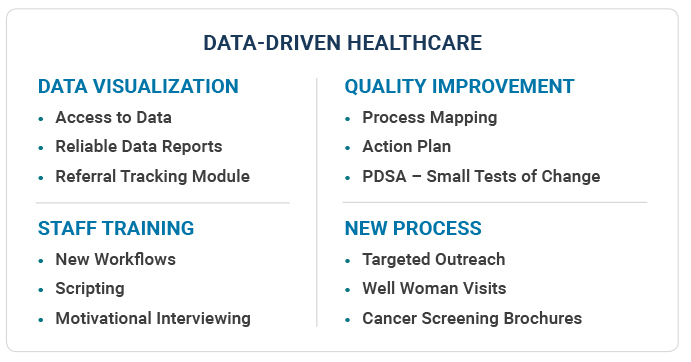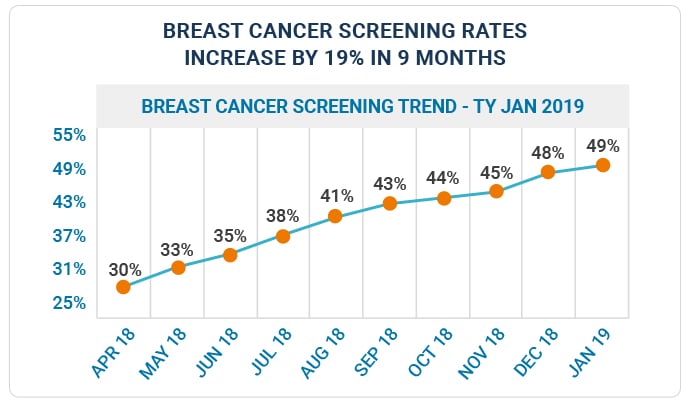Alaska Health Centers
Alaska Health Centers Improve Breast Cancer Screenings Using a Data-Driven Model with Azara DRVS as the Foundation for Patient Identification, Referral Tracking, and Reporting
Breast Cancer Screening in Alaska
Approximately 46,000 Alaskan women receive primary care services at their local community health center including comprehensive preventive services like cancer screenings. Breast cancer is the most commonly diagnosed cancer among women in the U.S. and is one of the top three diagnosed cancer types in Alaska. Predicting breast cancer risk on the basis of possible risk factors can be unreliable. Fully 70% of all women diagnosed with breast cancer had no known risk before the time of diagnosis and the percentage of Alaska women ages 50-74 who have had a mammogram within the past two years dropped over the past ten years.*
Alaska’s 750,000 residents are dispersed among more than 350 communities, most of which are not on the state’s road system. Each community is unique in demographic characteristics, local health services, and ease of access to resources in larger hub communities. Twenty-one communities have mammography capabilities, and 2 mobile mammography units visit communities along the road and ferry network* with some patients requiring flight services to obtain a mammogram.
Alaska’s Health Center Controlled Network (HCCN) is a program of the Alaska Primary Care Association (APCA) and is comprised of 13 participating health centers, all utilizing Azara DRVS for population health reporting and quality analytics. The Alaska Quality Improvement Network (AQuIN) is made up of all Alaska health centers including those health centers participating in the HCCN. AQuIN is also part of the Alaska Center for Healthcare Quality (ACHQ), a division of the APCA. AQuIN’s purpose is to support participating health centers by working together to advance the use of health information and analytics to improve and sustain the quality of care and health outcomes of patients. APCA procured Azara DRVS for specific community health centers where UDS data and other health, financial, and performance measures would be captured and analyzed.
AQuIN then developed the following goals:
- Realize healthcare cost savings by identifying and increasing primary care screenings and preventive activities.
- Increase quality transparency with funders, policy-makers, patients and the public.
- Improve care coordination within health centers and communities.
- Facilitate health center transformations by using a technology solution that supports highly efficient, team-based care delivery models.
- Empower health centers with their own analyzed data, allowing them to make and measure improvements and be ready to enter value-based agreements with carriers.
Though breast cancer screening rates have been slowly increasing among APCA HCCN participants, rates are still below the Healthy People guideline of 81.1%. The ACHQ team proposed breast cancer screening as the first high-impact measure to aim for improvements.
Data-Driven Healthcare Using Azara DRVS
AQuIN convened a Data Summit in April 2018 and brought together key health center personnel from across the state. One area the attendees reviewed was breast cancer screening processes, identifying gaps in patient follow up, and strategized on how information should come back into their systems to gain credit for a completed mammogram order.

For the health centers without mammogram equipment, staff refer patients to the most convenient breast cancer screening location. Centers then receive results via paper or fax, which are then attached manually to a patient’s record. This former workflow and lack of technology integration created a pitfall for clinicians and patients.
- It was difficult to track patients who did not get a mammogram,
- the hard copy file made it a challenge to interpret screening results, and
- critical patient follow up plans could be overlooked.
Improving breast cancer screening has the potential to save lives, lower costs, and pilot methods for managing abnormal diagnostics. Using the data analytics tools and a patient registry provided by Azara DRVS, AQuIN set out to improve breast cancer screening rates using a new data-driven model set forth at the Data Summit. Health centers identified patients due for a mammogram using the new patient registry. Once identified, health centers would outreach to patients to encourage screenings and use the DRVS Visit Planning Report to ensure care team intervention at the health center. The new workflow and available referral data also enabled the care team to track mammogram completion.
The availability of structured data and reports within DRVS also empowers AQuIN and their health centers to access accurate, trustworthy performance data. For the first time, they can solve issues and synthesize statewide and health center-based information for funding and advocacy opportunities using real data available at their fingertips.
Methods
Through contracts with the State of Alaska (SOA), APCA staff has the opportunity to work with health centers to retrieve their data and create reports that help identify and manage their populations and provide outreach and patient education on breast cancer screening. Training staff on using the Referral Module as a tracking tool to help manage and coordinate care patients received outside of the health center has been invaluable in providing access to referrals and closing the loop. The contract that allowed for the purchase of the Referral Module required health centers to report their data and work on improvement, incentivizing health centers to quickly learn how to use the tool and develop Plan-Do-Study-Act’s (PDSA) around improving breast cancer screening.
Results
Measuring the use of recommended breast cancer screenings is important for identifying groups that might not be receiving the full benefits of screenings, ultimately resulting in cost reductions and lives saved. By June 2018, four health centers had adopted the use of Azara DRVS. Within 7 months of using DRVS these four health centers improved breast cancer screening rates from 31% to 46% for their patients age 50-74 and realized a potential $1.5 million dollars of savings to the Alaska health system. This 15% improvement set the stage to continue training other health centers to transform their practices using the same data-driven model. As APCA continues to add additional participating health centers to Azara DRVS, Alaska’s breast cancer screening rates continue to improve; currently breast cancer screening rates among Alaska health centers using Azara DRVS is at 52%.

Scalability
Health centers are now using the new workflows and available data to improve breast cancer screening rates at their sites. The scalability of the data-driven model has enabled the Alaska PCA to acquire additional funding from the Centers for Disease Control (CDC) through the State of Alaska (SOA), Alaska Native Tribal Health Consortium (ANTHC), and the National Association of Community Health Centers (NACHC). They are expanding use of the data-driven model of care to improve measures for additional cancer screenings, diabetes, hypertension, and immunizations.
